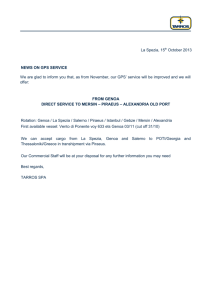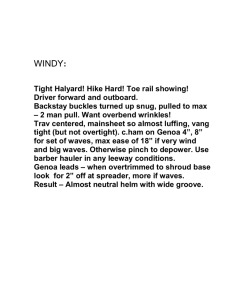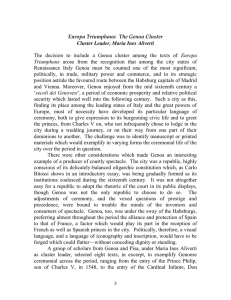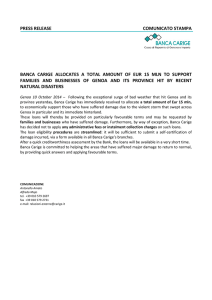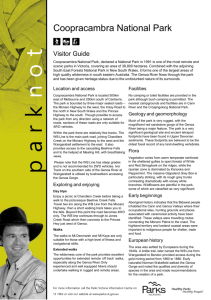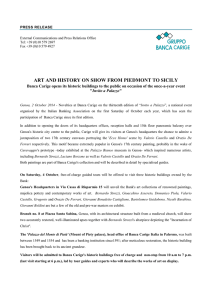Research Journal of Applied Sciences, Engineering and Technology 7(12): 2463-2468,... ISSN: 2040-7459; e-ISSN: 2040-7467
advertisement
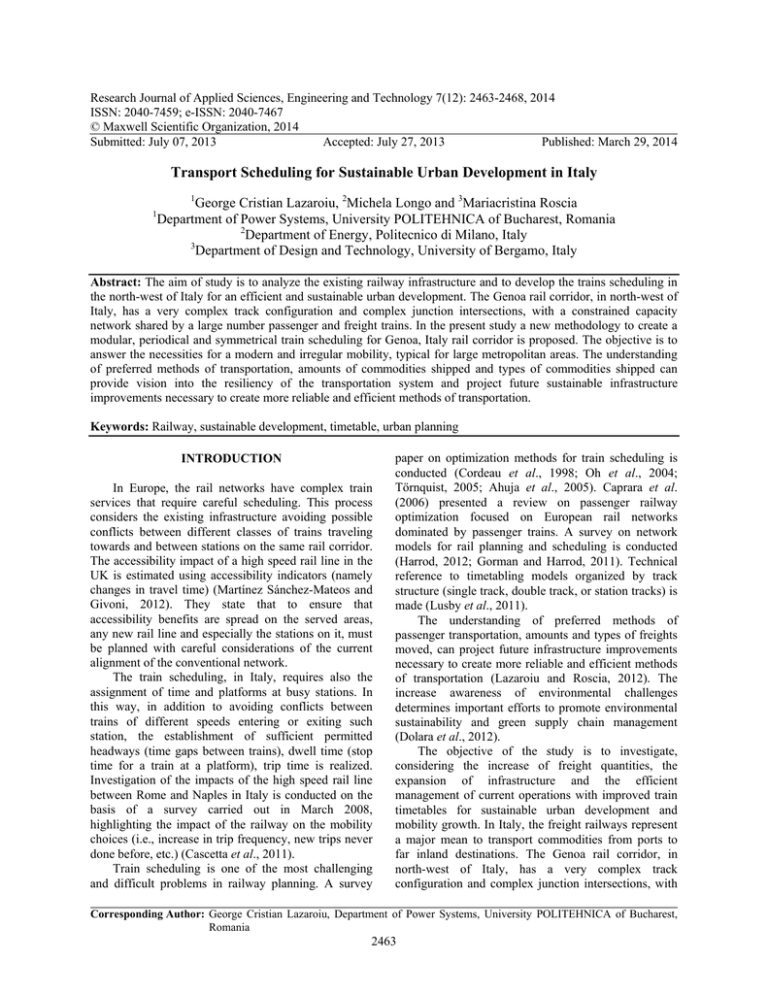
Research Journal of Applied Sciences, Engineering and Technology 7(12): 2463-2468, 2014 ISSN: 2040-7459; e-ISSN: 2040-7467 © Maxwell Scientific Organization, 2014 Submitted: July 07, 2013 Accepted: July 27, 2013 Published: March 29, 2014 Transport Scheduling for Sustainable Urban Development in Italy 1 George Cristian Lazaroiu, 2Michela Longo and 3Mariacristina Roscia Department of Power Systems, University POLITEHNICA of Bucharest, Romania 2 Department of Energy, Politecnico di Milano, Italy 3 Department of Design and Technology, University of Bergamo, Italy 1 Abstract: The aim of study is to analyze the existing railway infrastructure and to develop the trains scheduling in the north-west of Italy for an efficient and sustainable urban development. The Genoa rail corridor, in north-west of Italy, has a very complex track configuration and complex junction intersections, with a constrained capacity network shared by a large number passenger and freight trains. In the present study a new methodology to create a modular, periodical and symmetrical train scheduling for Genoa, Italy rail corridor is proposed. The objective is to answer the necessities for a modern and irregular mobility, typical for large metropolitan areas. The understanding of preferred methods of transportation, amounts of commodities shipped and types of commodities shipped can provide vision into the resiliency of the transportation system and project future sustainable infrastructure improvements necessary to create more reliable and efficient methods of transportation. Keywords: Railway, sustainable development, timetable, urban planning INTRODUCTION In Europe, the rail networks have complex train services that require careful scheduling. This process considers the existing infrastructure avoiding possible conflicts between different classes of trains traveling towards and between stations on the same rail corridor. The accessibility impact of a high speed rail line in the UK is estimated using accessibility indicators (namely changes in travel time) (Martínez Sánchez-Mateos and Givoni, 2012). They state that to ensure that accessibility benefits are spread on the served areas, any new rail line and especially the stations on it, must be planned with careful considerations of the current alignment of the conventional network. The train scheduling, in Italy, requires also the assignment of time and platforms at busy stations. In this way, in addition to avoiding conflicts between trains of different speeds entering or exiting such station, the establishment of sufficient permitted headways (time gaps between trains), dwell time (stop time for a train at a platform), trip time is realized. Investigation of the impacts of the high speed rail line between Rome and Naples in Italy is conducted on the basis of a survey carried out in March 2008, highlighting the impact of the railway on the mobility choices (i.e., increase in trip frequency, new trips never done before, etc.) (Cascetta et al., 2011). Train scheduling is one of the most challenging and difficult problems in railway planning. A survey paper on optimization methods for train scheduling is conducted (Cordeau et al., 1998; Oh et al., 2004; Törnquist, 2005; Ahuja et al., 2005). Caprara et al. (2006) presented a review on passenger railway optimization focused on European rail networks dominated by passenger trains. A survey on network models for rail planning and scheduling is conducted (Harrod, 2012; Gorman and Harrod, 2011). Technical reference to timetabling models organized by track structure (single track, double track, or station tracks) is made (Lusby et al., 2011). The understanding of preferred methods of passenger transportation, amounts and types of freights moved, can project future infrastructure improvements necessary to create more reliable and efficient methods of transportation (Lazaroiu and Roscia, 2012). The increase awareness of environmental challenges determines important efforts to promote environmental sustainability and green supply chain management (Dolara et al., 2012). The objective of the study is to investigate, considering the increase of freight quantities, the expansion of infrastructure and the efficient management of current operations with improved train timetables for sustainable urban development and mobility growth. In Italy, the freight railways represent a major mean to transport commodities from ports to far inland destinations. The Genoa rail corridor, in north-west of Italy, has a very complex track configuration and complex junction intersections, with Corresponding Author: George Cristian Lazaroiu, Department of Power Systems, University POLITEHNICA of Bucharest, Romania 2463 Res. J. Appl. Sci. Eng. Technol., 7(12): 2463-2468, 2014 a constrained capacity network shared by a large number passenger and freight trains. Thus, due to capacity constraints, more and more trains are traveling on a limited number of tracks, with freight railway using a reduced transport capacity. Efficient planning and scheduling tools are needed to manage the existing resources used also for passenger transportation. • Administrative and geographic complexity: The analyzed metropolitan area is the so called Genovesato, i.e., the hinterland of Genoa city where 1250000 citizens are living, of which more than half is outside Genoa city. Convergence of 3 national lines and 1 local line: The Genoa node represents the intersection of three railway lines: Turin/Milan-Genoa, GenoaVentimiglia-France and Genoa-Pisa-Rome. In addition, a local line Genoa-Ovada-Acque Terme is entering the Genoa railway node. The port existence: The Genoa port is developing in accordance with city demand. Small urban center: From geographical point of view, Genoa city is placed between the sea and the mountains. This implies the superposition of railway lines with street and highway systems, • MATERIALS AND METHODS Genoa, the residence of Liguria district, represents an administrative area of 23458 ha plus 427 ha of port area. The population is about 612000 citizens and represents the larger port for merchandise transportation (58 mil. t in 2007). The peculiarity of the analyzed node consists of: • • Arquata Scrivia Lines 2 Legend 1 Ronco j. RONCO SCRIVIA I 1 Giovi line 2 Succursale line Gallery line Disaffected line 2a Succursale line via Sussidiario Not-used joint or stop 2 2b Succursale line via Bastioni 1 Used station or stop Busalla j. 3 Granarolo line 4 S.Lazzaro Alta line 5 S.Lazzaro Bassa line 6 Ponente line 7 Ovadese line I 8 Traversata Vecchia line II Rivarolo junction – Bersaglio junction 9 Traversata Nuova line III Voltri connection Freight halt BORGO FORNARI 2 MIGNANEGO 1 BUSALLA PIANO ORIZZONTALE DEI GIOVI GENOA PONTEDECIMO 1 2 S. Quirico GENOA S. BIAGIO 10 S.Tomaso line 11 C.Colombo line 12 Levante line Connections IV Molini curve V Rivarolo – Campasso junction GENOA BOLZANETO 17 Double junction Tegino Succursale Ronco junction – Busalla junction VIa S. Limbania junction Rivanolo j. 13 Sommergibile line 14 del Campasso line VIb S. Benigno – S. Limbania junction V 3 17 2 14 Fegino 7 Ovada GENOA GENOA ACQUASANTA COSTA 7 GENOA GRANARA 7 GENOA BORZOLI III Polcevere j. 2 15 del Trincerone line 16 del Romairone line 17 Trasta-Campi line 18 Voltri Mare line V II GENOVA RIVAROLO 1 Compasso N Torbello 14 Quadrivio Corvi j. 17 2b Sampierdarena Smistamento Compasso S 3 GENOA PIAZZA PRINCIPE S.Limbania 14 j. IVa Savona III GENOA VOLTRI 6 18 Voltri Mare Sampierd. Forni GENOA SESTRI PON. GENOA 6 PEGLI GENOA PRA IV 5 2a 2b VIa 14 16 Santa Limbania VIb San Benigno Fig. 1: Infrastructure of Genoa rail corridor 2464 10 5 4 6 6 5 GENOA Cornigliano GENOVA CORNIG. j. SAMPIERDARENA 13 Sommergibilo 15 13 j. Bacino 9 8 4 2a 13 11 3 4 Campi Traversata j. Terralba 8 9 GENOA GENOA QUARTO NERVI 8 12 GENOA 12 GENOA STURLA GENOA BRIGNOLE QUINTO La Spezia Fegino j. Freight belt Res. J. Appl. Sci. Eng. Technol., 7(12): 2463-2468, 2014 • The railway tracks in Genoa node are extremely complex and meshed, particularly in the triangle Bolzaneto, Sampierdarena and Principe Square. Figure 1 illustrates the Genoa rail corridor, highlighting the track lines and junction lines. In addition, the passenger and freight stations are shown. The infrastructure of the rail corridor Genoa-North (Giovi 1 and Succursale 2 track lines) have double track corridor. The coastal corridors of Ponente and Levante have infrastructure constraints and small capacity. The Ponente rail corridor enters in the Genoa city through two tracks, illustrated in Fig. 1 with the numbers (4) and (5). The coastal railway of Levante has four lines between Principe Square and Brignole Station and additional two lines are entering the underground path Bivio Traversata. In particular, the urban rail corridor illustrated in Fig. 1 comprises the Traversata Vecchia line (8) toward the sea, Traversata Nuova line (9) toward the mountain, the San Tomaso line (10) which is the even track of San Lazzaro-Bassa rail and the Cristofor Columb line (11) which is the odd track of San Lazzaro-Bassa rail. For completeness, the Ovadese line (7) is creating a junction with Succursale line within the unused Polcevera station. The critical complexity of Genoa infrastructure node is observed within the triangle Rivarolo, Sampierdarena and Piazza Principe. The freight rail corridor is a ring network connecting the North route, through the double unused stations Fegino Succursale, with the discharging stops of Sampierdarena, Bacino, San Benigno, Campasso and afterwards again with the North route. Thus, the Genoa node allows the freight exchange between the Port and the Padana plain, without the inversion of freight trains traveling direction. In this way, a transshipment development is achieved. However, nowadays, the freight rail corridor is not infrastructural homogeneously both from capacity and electrification point of views. Million tones 58 56 54 52 50 48 46 2004 2005 2006 2007 2008 2009 2010 2011 Fig. 2: Variation of total freights displacement within Genoa port between 2004 and 2011 Freight trains/year • 60 180 160 140 120 100 80 60 40 20 0 2004 2005 2006 2007 2008 2009 2010 2011 Fig. 3: Variation of freight trains within Genoa port between 2004 and 2011 2.600 2.500 2.400 Million • leading to a competition for best use of coastal and mountain corridors limited by hydrologic constraints. Position as “entrance for Europe”: Passing point between Europe and countries at the Mediterranean sea, like Africa countries. Infrastructure constraints of the railway lines: Mainly represented by slope, curve and underground railway lines. High service heterogeneity: The city railway node is highly heterogeneous as long and average distance trains, regional and merchandise trains are entering the Genoa city. This fact critically affects the coastal corridors, where many trains are using only single line for both moving directions. 2.300 2.200 2.100 2.000 1.900 2007 2008 2009 Year 2010 2011 Fig. 4: Variation of passenger×km of Liguria regional rail transport The leadership port position of Genoa is contradictory and unbalanced due to an inadequate inter-modality planning between then avalandrail transportation. The variation of total freights moved within the Genoa port between 2004 and 2011 is illustrated in Fig. 2. The variation of freight trains in the Genoa port between 2004 and 2011 is illustrated in Fig. 3. Comparing the total freights displacement (Fig. 2) and the variation of freight trains within Genoa port (Fig. 3), separately developments need to be fulfilled, as the two systems are independent one with the other. The lack of offers for passengers is observed analyzing the variation of train’s demand in Liguria, Italy between 2465 Res. J. Appl. Sci. Eng. Technol., 7(12): 2463-2468, 2014 2007 and 2011. As shown in Fig. 4, the variation of passenger×km of regional rail transportation decreased between 2007 and 2011. The data report an increase of sparse mobility all day long, with increase both of duration and distance and also a growth of the mobility index (number of travels/day per capita). In order to analyze the existing train offer, the comparison between the regional and global train demands was considered not sufficient. Thus, a depth study of train scheduling for year 2012 was conducted. The analyzed parameters are: • o o • o o o For each one-way line: Hourly distribution of services in business and week-end days, obtaining in this way the services frequency Number of stops per facility For each single train: Train frequency Itinerary, departure/destination Type of train (number of stops, journey times) • A new scheduling is proposed for the rail corridor Genoa-La Spezia, with imposed symmetry at station Genoa Brignole. The timetable elaboration on this corridor was preceded by an analysis of the infrastructural characteristics and installations along the corridor. In this way a complete picture of stations’ capacity is elaborated. Thus, the possible meeting and passing between trains with different speeds are established. The various train services on this corridor are identified as: • The conclusions of the conducted study are: • • • • • Lack of association between minute and trainlack of mnemonicity More itineraries for the same route (e.g., MilanGenoa two different routes, Turin-Genoa two different routes etc.) Train class not clearly determined (regional train routes like Genoa-Albenga and Genoa-Alassio, with a distance of 85 km, with stations only in major cities; interregional train routes like SavonaLivorno and Ventimiglia-Parma, with a distance of 350 km, with neighboring stations, typical for a subway service Interregional services practically missing in the Ponente Riviera, with trains every 6 h during business days Excessive presence of various trains: 93 trains along the 4 Liguria directions RESULTS AND DISCUSSION The infrastructure developments require adopting a precise scenario for applying the train timetable proposed in the present study. Some strategies can be adopted to develop the Genoa port towards a “transshipment” concept, such as to speed up the intermodal operation using: • • Structures dedicated for cargos, as the freight sector is fast developing. Areas specialized for conventional commodities, as the freight sector has the highest added value. The development of industry functions related to freight movement, organized in so-called districtpark, is required. Reorganization of freight rail system for the northwest part of Italy (Terzo Valico, Bretella and Pontremoltese). • • • • Suburban corridor Genoa-Sestri Levante with trains every 15 min (without intermediate stops between Brignole and Nervi): 4 regional R trains/hour in each direction creating a service frequented as much as the line is close to the city (lines: Ventimiglia-Genoa, Taggia-Sestri Levante, Albenga-Sestri Levante, Savona-La Spezia, GenoaSarzana) Urban corridor Brignole-Nervi with trains every 15 min: 4 metropolitan M trains/hour in each direction Genoa Voltri-Genoa Nervi Interregional trains along line Genoa-La Spezia: 1 interregional IR train/hour in each direction at hours alternated between line Milan-La Spezia and line Torino-Livorno Intercity train along line Genoa-La Spezia/ Florence/Rome: 1 intercity IC train/hour in each direction at hours alternated between line MilanoLa Spezia and line Ventimiglia-Firenze/Roma Eurostar train along line Genoa-La Spezia/ Florence/Rome: 1 eurostar ES train/hour in each direction at hours alternated between line MilanoLa Spezia and line Ventimiglia-Firenze/Roma The realization of timetable for the Levante rail corridor requires the node scheduling, i.e., imposing the symmetry at Brignole and Sampierdarena stations. This requires the scheduling of Genoa urban routes, which constitute the tracks where all directions converge. In Fig. 5, the timetable corresponding to Genoa Brignole station is illustrated. In Fig. 5, the train type is represented with a colored arrow and is indicated using roman numbering. Near the roman number are highlighted the train classes (e.g., M, R, IR etc.), the origin and destination stations and the departure minute and symmetry (e.g., “s30” represents symmetry with respect to the min 0.30). 2466 Res. J. Appl. Sci. Eng. Technol., 7(12): 2463-2468, 2014 I ES* II R III ES* IV IC/ES* V R LA SPEZIA - VENTIMIGLIA GENOA - ARQUATA S. LA SPEZIA - MILAN e GENOA - TURIN ALBENGA – SESTRI L. s 00 s 00 s 00 s 00 s 00 VI R GENOA - VENTIMIGLIA VII iR LA SPEZIA - MILAN VIII iR d LA SPEZIA - TURIN p GENOA - TURIN IX R GENOA – ALESSANDRIA I II pp III p XVI IV V XX XXIII 03 05 55 2" 53 VI XVII 07 08 52 50 XIX XVIII G E N O A B R I G N O L E 20 + 15 ‘ 38 XXI 25 35 33 XXII 32 28 27 30 XX V XVI XV iR R IC IC R R R XI VIII d VII 22 23 37 XXI X XI XII XIII XIV XV XVI IX p X d 15 40 XI VI p VII VIII 10 45 XV XVII s 15 s 15 d III IV 00 XXII XXIII s 00 s 15 XII GENOA - VENTIMIGLIA LA SPEZIA - TAGGIA LA SPEZIA - MILAN LA SPEZIA - VENTIMIGLIA GENOA – NOVI L. GENOA – ACQUI T. e SAVONA – SESTRI L. d XIII p XIII XIV s 15 s 30 s 30 s 30 s 30 s 30 s 45 XVII XVIII XIX XX XXI XXII XXIII IC/ES* iR R M M M M p XII GENOA - BOLOGNA GENOA - NOVARA GENOA - TORTONA GENOA B.le – GENOA V. GENOA B.le – GENOA V. GENOA B.le – GENOA V. GENOA B.le – GENOA V. s 45 s 45 s 45 s 15 s 30 s 45 s 00 Fig. 5: Genoa brignole timetable resulted based on the proposed Genoa node scheduling Table 1: Increases of number of trains on railway line Genoa-sestri levante Regional trains 2015 2008 (%) Genoa brignole-Genoa nervi 64 45 42.22 Genoa nervi-recco 64 33 93.94 Recco-sestri levante 64 24 166.67 Genoa nervi-Genoa brignole 68 44 54.55 Recco-Genoa nervi 68 32 112.50 Sestri levante-recco 68 23 195.65 Interregional trains 2015 2008 (%) Genoa brignole-sestri levante 15 9 66.67 Sestri levante-Genoa brignole 15 11 36.36 Intercity trains 2015 2008 (%) Genoa brignole-sestri levante 15 15 0.00 Sestri levante-Genoa brignole 14 15 -6.67 Eurostar trains 2015 2008 (%) Genoa brignole-sestri levante 14 1 1300 Sestri levante-Genoa brignole 12 1 1100 For two lines, traveled by train III and respectively train XV, exceptions (‘knock-ons’) are introduced and highlighted by the letter “e”. For the first exception, the train III (eurostar ES train travels from La Spezia to Milano) arrives at Genoa Brignole station from Levante at min 0.03, instead of min 0.05 (due the departure of eurostar ES train Milano-La Spezia that leaves Brignole station toward Levante at min 0.55). This time delay is determined by the infrastructural constraints of Levante rail corridor. The second exception refers to the train number XV from Genoa to Acqui Terme. This train is delayed (‘knocked-on’), arriving at Genoa Brignole station at min 0.35, instead of min 0.20 (with regional R train from Acqui Terme to Genoa exiting Genoa Brignole toward Acqui Terme at min 0.40). The exception from the symmetry principle is determined by the constraints of one-way line on Ovadese and insertion of 5 min headway in the time corridors (minimum headway imposed by Trenitalia). The number of trains/hour in each direction is determined on each route of the node. This is very useful for identifying, considering the 2015 scenario, possible occurrences of saturation or possible potentialities to be fructified. A detailed offer analysis, considering the 2015 scenario, is conducted based on the elaborated proposal. The increasing number of trains on Levante rail corridor is reported in Table 1. 2467 Res. J. Appl. Sci. Eng. Technol., 7(12): 2463-2468, 2014 The reported results show an important increment of train offers, as consequence of infrastructural projects aimed to satisfy precise and planned objectives. The presented measures, to fulfill their development objectives, have to be carefully analyzed for achieving the equilibrium between the capacity and offer to be implemented. This requires precise acknowledgements to boost the train services. The important increase of passenger trains frequency is possible only after applying a systemic management method for the rail corridor, capable to elaborate a modular train timetable at the end-user service. CONCLUSION The understanding of preferred methods of transportation, amounts of commodities shipped and kinds of commodities shipped can provide insight into the resiliency of the transportation system and project future infrastructure improvements necessary to create more reliable and efficient methods of transportation. The study of train timetables requires the detail analysis of infrastructural capacities of the major city rail corridors. In this way, an agreement between the proposal of services and the management of trips and stops for passengers’ trains is investigated. Hence, the occupying degree of Genoa tracks is investigated, considering the future infrastructural investments. The most interesting case refers to Genoa Brignole station. This station is be able to achieve a 200% increase of services on the track lines entering Genoa, by planning only 2 additional track lines and additional 3 track lines for freight trains at Terralba station. The favorable aspects of the project, leading to a potential half hour service during the entire day, are: • • • • • • Second doubling track with small investment costs Insertion of the line in the districtual Genoa system with a base frequency of 30 min Large potential for extra urban demand: 24638 habitants in Stura valley Large potential of urban demand: about 15000 habitants in the Sestri Ponente districts in Genoa Presence in the vicinity of Genoa Costa stop of several services, like Genoa hospital of Sestri Frequent requests by passenger associations and users The drawbacks of the project are: • • First doubling track with large investment costs Non-symmetrical relations in Sampierdarena for maintaining the intersections in the equipped installations REFERENCES Ahuja, R.K., C.B. Cunha and G. Şahin, 2005. Network Models in Railroad Planning and Scheduling. In: Harvey and J. Greenberg (Eds.), Tutorials in Operations Research, Emerging Theory, Methods and Applications. Institute for Operations Research and the Management Sciences, Hanover, MD, pp: 54-101. Caprara, A., M. Monaci, P. Toth and P.L. Guida, 2006. A lagrangian heuristic algorithm for a real-world train timetabling problem. Discrete Appl. Math., 154: 738-753. Cascetta, E., A. Papola, F. Pagliara and V. Marzano, 2011. Analysis of mobility impacts of the high speed Rome-Naples rail link using within day dynamic mode service choice models. J. Transp. Geogr., 19: 635-643. Cordeau, J.F., P. Toth and D. Vigo, 1998. A survey of optimization models for train routing and scheduling. Transp. Sci., 32(4): 380-404. Dolara, A., F. Foiadelli and S. Leva, 2012. Stray current effects mitigation in subway tunnels. IEEE T. Power Deliver., 27(4): 2304-2311. Gorman, M.F. and S. Harrod, 2011. Operations Research Approaches to Asset Management in Freight Rail. In: Wiley Encyclopedia of Operations Research and Management Science, John Wiley and Sons, Inc., New York. Harrod, S.S., 2012. A tutorial on fundamental model structures for railway timetable optimization. Surv. Oper. Res. Manage. Sci., 17(2): 85-96. Lazaroiu, G.C. and M. Roscia, 2012. Definition methodology for the smart cities model. Energy, 47(1): 326-332. Lusby, R.M., J. Larsen, M. Ehrgott and D. Ryan, 2011. Railway track allocation: Models and methods. OR Spectrum, 33(4): 843-883. Martínez Sánchez-Mateos, H.S. and M. Givoni, 2012. The accessibility impact of a new high-speed Rail line in the UK-a preliminary analysis of winners and losers. J. Transp. Geogr., 25: 105-114. Oh, S.M., S.H. Hong and I.C. Choi, 2004. Railway Conflict Detection and Resolution in the Korean Railway System. In: Allan, J., C.A. Brebbia, R. Hill, G. Sciutto and S. Sone (Eds.),Computers in Railways IX. WIT Press, Southampton, UK, pp: 675-684. Törnquist, J., 2005. Computer-based decision support for railway traffic scheduling and dispatching: A review of models and algorithms. Proceeding of 5th Workshop on Algorithmic Methods and Models for Optimization of Railways, ISBN: 9783-939897-00-2. 2468
